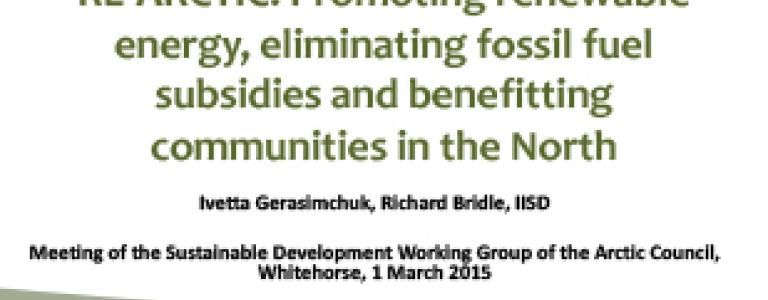RE-ARCTIC: Promoting renewable energy, eliminating fossil fuel subsidies and benefitting communities in the North
The International Institute for Sustainable Development (IISD) presented its vision of renewable energy development to the Sustainable Development Working Group of the Arctic Council in Whitehorse on March 1, 2015.
Renewable sources seem to be a straightforward way to provide “sustainable energy for all” in the Arctic. The Arctic has vast reserves of renewable energy, including hydro-, bio-, wind and geothermal power. Renewable energy technologies have been successfully tested and put in operation in the Arctic. Large-scale hydropower accounts for up to 75 per cent of electricity in Greenland and a significant share of electricity supply in northern Norway, Russia, Iceland and some other parts of the Arctic.
Small-scale renewable energy technologies and off-grid solutions for remote communities have also been successfully applied in the Arctic. There are striking similarities and synergies in terms of renewable energy solutions for small remote communities in the Arctic and in small island and archipelago states, in some of which (for instance, the Philippines or Cape Verde) renewable energy accounts for 25 to 30 per cent of electricity generation, with successful off-grid installations.
Yet, despite this evidence in favour of renewable energy development in the Arctic, the uptake of renewable energy in the region has been slow. The work that IISD has undertaken on successful policies for deployment of renewables around the world suggests several lessons learned that may be highly relevant for the Arctic:
Clear long-term targets and policies supporting renewables are essential to ensure investors’ decisions.
Phase-out of subsidies to fossil fuels (such as highly subsidized diesel in the Arctic), is essential to promote renewable energy. Subsidies to fossil fuels distort the playing field for renewable energy that can be cost-competitive in remote communities if there are no such distortions.
Public–private partnerships are essential; dedicated funds to support renewable energy development can be accumulated in a number of ways, including through environmental taxes (carbon tax, taxes on pollution, etc.).
Market integration on both the supply and demand sides is important to bring down the costs of renewable energy, which requires cooperation and synergies across different jurisdictions in the Arctic.
You might also be interested in
The Cost of Fossil Fuel Reliance
Government support for fossil fuels reached at least USD 1.5 trillion in 2023, new data shows.
Increased Support Needed to Achieve India's Clean Energy Goals
India is on track to achieve many of its 2030 clean energy goals but needs to step up government support measures to accelerate the deployment of offshore wind, electric vehicles, and green hydrogen, according to a new report.
Ending Export Credits for Oil and Gas: How OECD countries can end 2024 with a climate win
For a year now, Organisation of Petroleum Exporting Countries (OECD) governments have been negotiating an agreement that could put an end to oil and gas export finance. Following the acrimony in Baku, this would be a very real way for the OECD to show policy coherence, respond to calls from the poorest countries to stop subsidizing fossil fuels, and shift public finance to solutions.
Fossil Fuel Production, Renewable Energy, and Subsidy Reform in Nationally Determined Contributions 3.0
This policy brief provides an analysis of the critical benchmarks and recommendations necessary for aligning nationally determined contributions (NDCs) with the 1.5 °C target.
